Caravans. What are the factors that separate the great from the good, the bad from the ugly? I reckon it’s all about how the caravan is built, its fitness for purpose, the quality and type of features, and the layout.
A remarkable van combines these factors without calling attention to itself. It’s impressive but not arrogant, eye-catching but not ostentatious. Truth be told, with its purposeful posture and smooth composite fibreglass panels the new Roadstar Sirius can’t help but turn eyeballs in its direction.
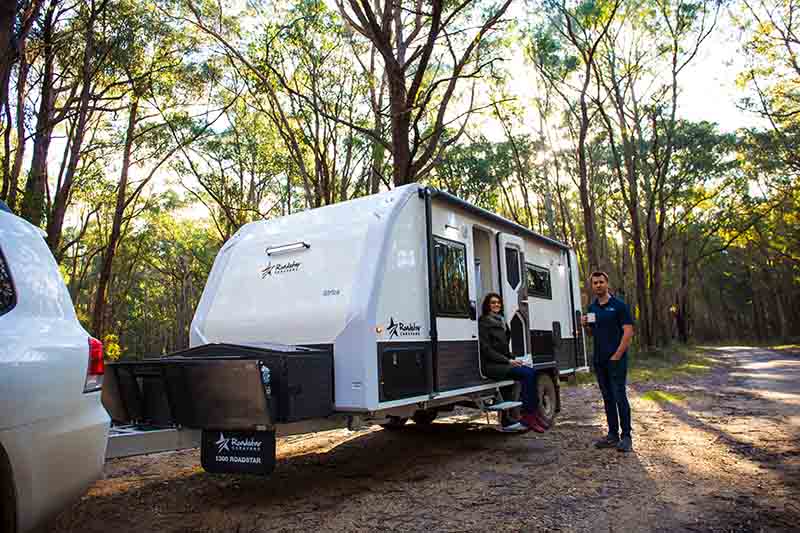 This time last year, the closest a Roadstar van came to fibreglass was if its owner packed a surfboard. While the company still builds timber-framed vans clad with ribbed aluminium – the direct descendants of the original Roadstar caravans – when it comes to fibreglass sandwich panel caravans, the Sirius is ample evidence that Roadstar has hit its stride.
This time last year, the closest a Roadstar van came to fibreglass was if its owner packed a surfboard. While the company still builds timber-framed vans clad with ribbed aluminium – the direct descendants of the original Roadstar caravans – when it comes to fibreglass sandwich panel caravans, the Sirius is ample evidence that Roadstar has hit its stride.
“I’ve always wanted Roadstar Caravans to be the best,” owner Ken Nizam said. “To me, it’s not enough for our customers to just be happy with their van; I want them to be proud of it.”
BUILDING SIRIUS
First, how is the Sirius built?
The van rides on a hot-dipped galvanised Australian Hitec Engineering chassis on Cruisemaster XT independent offroad suspension, though you could fit airbag suspension is you preferred.
“This van has a 45mm-thick composite floor that’s bonded to the chassis with a particularly strong adhesive and high-tensile anchor points,” Ken said.
The roof is a one-piece composite fibreglass sandwich panel extending from the front of the van to the very rear of the chassis, while the two side walls are one-piece panels too. The floor, roof and wall sections are locked together by aluminium extrusion and that same adhesive.
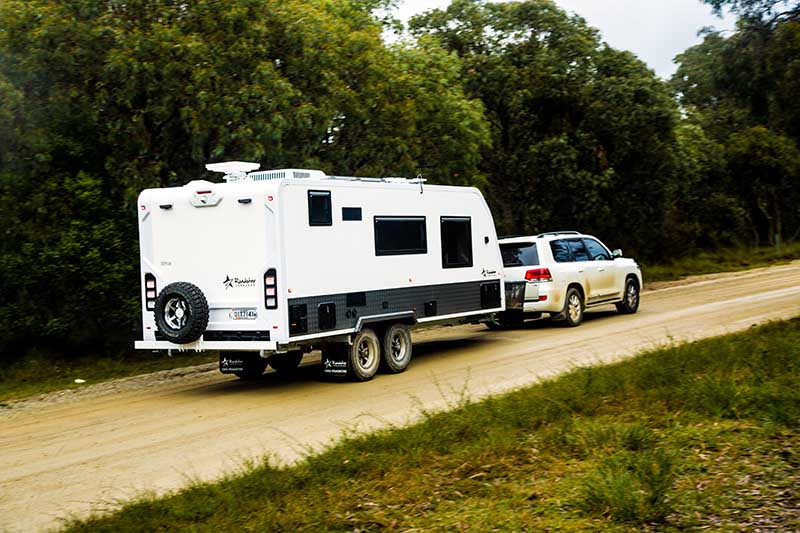 “The way each panel locks together is how this van gets its strength – although the panels are separate, they come together in a way that makes the Sirius virtually a one-piece composite fibreglass sandwich panel caravan.”
“The way each panel locks together is how this van gets its strength – although the panels are separate, they come together in a way that makes the Sirius virtually a one-piece composite fibreglass sandwich panel caravan.”
What’s more, the design of the van can’t necessarily be reproduced by Joe Bloggs down the road. Roadstar designed moulds specifically for this van, ensuring the Sirius will always have a unique appearance.
“It was important to us to make the Sirius stand out from other fibreglass vans, and the best way to do that was to invest in moulds to make our panels distinctive, especially the one-piece front, roof and rear.”
Mission accomplished. The Sirius is indeed distinctive. Neat as a pin, too, with an aesthetic uniformity befitting not only its price tag but its status as a high-end, luxury on and offroad tourer.
Upfront, the Sirius is fitted with a drawbar mounted gull-wing checkerplate storage box that serves a few purposes. On the nearside, this box has a slide-out tray for a portable fridge – a 12V point is fitted here, too, for constant power; the front of the storage box has a compartment for dual 9kg gas cylinders; and the offside has a slide-out for a generator. A jerry can holder either side and a mesh stoneguard complete the picture.
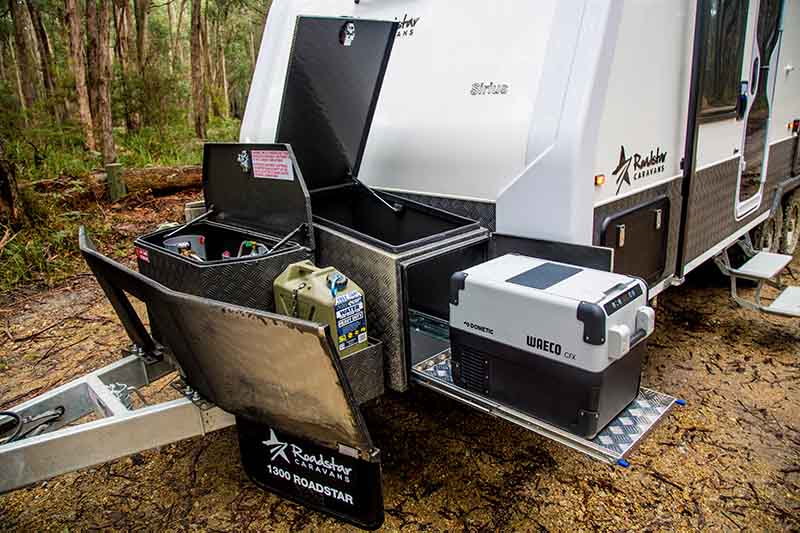 Because the Sirius has offroad intentions, Roadstar has opted for the well-regarded D035 coupling, and mounted to the fibreglass panel, just above the company logo, is an LED light bar.
Because the Sirius has offroad intentions, Roadstar has opted for the well-regarded D035 coupling, and mounted to the fibreglass panel, just above the company logo, is an LED light bar.
What would a luxury van such as this be without a slide-out kitchen? This stainless steel unit has hot and cold water, a Weber Baby Q that connects to the nearby gas bayonet and, sensibly, it’s out from under the awning. That way, should you fit annexe walls, you can still safely use the kitchen.
Further back, there’s a hatch to access the ‘entertainment box’, a marine carpet-lined compartment built into the side of the van with a TV mounting point, 12/240V powerpoints, antenna jack and even an HDMI cable – did I mention this van was fitted with an optional Sat King satellite dish? Quick tip: if you think you’d like to watch telly in the Back of Beyond, get the satellite dish fitted at the factory. When it comes to fibreglass sandwich panel vans, it’s much easier to run cabling when the van is being built, rather than later on. In fact, as part of the design, Roadstar includes special channels in the walls and behind the internal cabinetry, for all electrical wiring.
At the rear, you’ll find a reversing camera, the spare wheel, and a couple of high-mounted LED spotlights. Underneath, meanwhile, are two 95L water tanks as well as a 95L grey water tank. The underside of the van is neatly presented – there are no low-hanging pipes or wires to snag on shrubbery as you negotiate bush tracks.
On the offside is an external shower, allowing you to wash off that beach sand before stepping inside.
I particularly liked the side fibreglass mouldings that run the full length of the van – they add a sporty touch. Yes, from the outside the Sirius truly is a uniquely styled caravan.
BENCHMARK BENCHTOPS
We’ve come to expect a certain attention to detail from Roadstar. Does the finish inside the Sirius live up to expectations? Yes. And, in some ways, it exceeds them. I realise that’s lavish praise but there’s a ‘labour of love’ aspect that’s hard to define. Take, for example, the benchtops. They’re made of a polymer known as Hi-Macs. It is said to be stain and impact-resistant and, should you manage to damage it, it can be repaired.
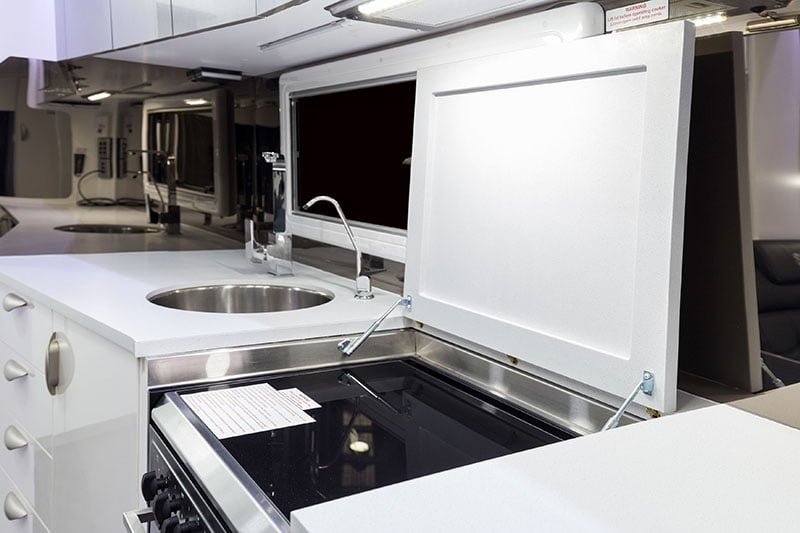 For the Sirius, two 12.5mm sheets of this material have been bonded together, then buffed and polished, over and again, until the joins have disappeared – at least, I couldn’t spot them. The round stainless steel sink is recessed into the bench, resulting in a finish reminiscent of a classy hotel room. Top marks.
For the Sirius, two 12.5mm sheets of this material have been bonded together, then buffed and polished, over and again, until the joins have disappeared – at least, I couldn’t spot them. The round stainless steel sink is recessed into the bench, resulting in a finish reminiscent of a classy hotel room. Top marks.
The rest of the kitchen is fitted with what you’d expect: an oven, a griller and a cooktop, along with a microwave and 12V Vitrifrigo compressor fridge. The dinette, meanwhile, is upholstered in leather, with each lounge fitted with a Sirius-embossed headrest that slides up like the headrests in a car. Very, very neat.
Beneath the rear lounge, Roadstar has included a 125Ah Enerdrive B-Tec lithium battery and matching charger. You’ll also find the 12V fuses here, along with the solar regulator for the dual 150W solar panels mounted on the roof. It adds up to a lot of 12V capacity which, coupled with the considerable fresh and grey water storage, will keep you longer off the grid.
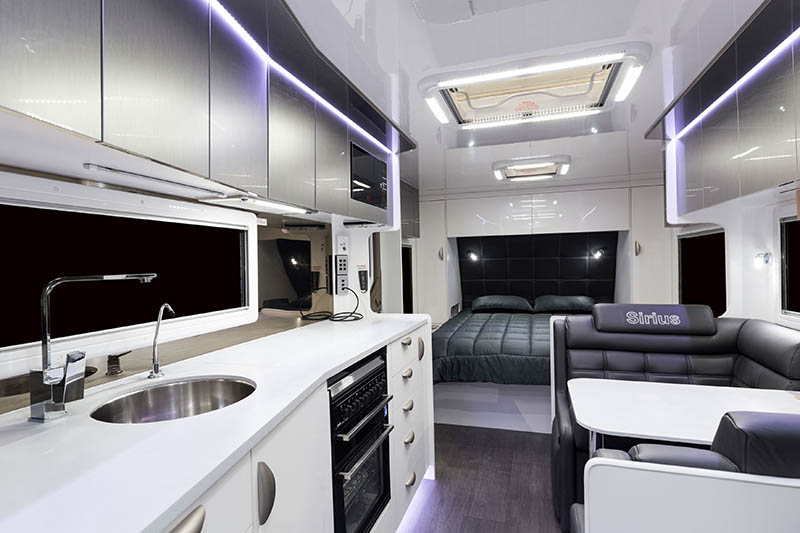 Up front, the wardrobes are of generous proportions, each with a storage nook and 240V powerpoint. In fact, the Sirius has a healthy dose of both 240V and 12V points throughout – including a couple of mains outlets mounted to the underside of the overhead lockers in the kitchen to reduce splashback clutter.
Up front, the wardrobes are of generous proportions, each with a storage nook and 240V powerpoint. In fact, the Sirius has a healthy dose of both 240V and 12V points throughout – including a couple of mains outlets mounted to the underside of the overhead lockers in the kitchen to reduce splashback clutter.
Speaking of overhead lockers, each has hidden catches, while soft-closing doors are fitted to the cupboards and pantry.
Across the rear of the Sirius is a bathroom with plenty of storage, including a large linen press, a washing machine, toilet and fully-moulded shower.
The soft-glow LED lighting throughout the van lends a pleasant, distinctly classy, ambience, a description that applies to the Sirius as a whole.
GORV’S VERDICT
I have spent considerable time trying to fault this caravan and thought I’d done it when I calculated that its water storage capacity (including grey water) and gas amounted to 303kg. Rechecking my notes, I saw the Sirius had 600kg of payload. Plenty.
What about the structure of the van? Would it hang together in offroad situations? I believe so. Storage? Well, there’s no front or tunnel boot but there is a full-height external compartment at the back of the van and the gull-wing box could be used, too.
Sirius is the name of the brightest star in our night sky. It’s a fitting name for this latest van in Roadstar’s orbit – the company’s new flagship shines brightly indeed.
THE SCORE
FIT AND FINISH – 
LAYOUT – 
INNOVATION – 
HITS & MISSES
COMPLETE SPECS
Overall length: 8.8m
External cabin length: 6.25m
External cabin width: 2.35m
Travel height: 3.1m
Internal height: 1.94m
Tare: 2670kg
GTM: 3010kg
ATM: 3270kg
Unladen ball weight: 260kg
Frame/panelling: Fibreglass sandwich panel walls, roof and floor
Coupling: DO35
Chassis: Hot-dipped galvanised
Suspension: Cruisemaster XT independent
Brakes: Electric
Wheels: 16in
Fresh water: 2x95L
Grey water: 1x95L
Awning: Dometic roll-out
Battery: 125Ah lithium
Solar: 2x150W
Air-conditioner: Ibis roof-mounted
Gas cylinders: 2x9kg
Sway control: No
Cooking: Swift four-burner cooktop with griller and oven
Refrigeration: Vitrifrigo 12V
Microwave: Yes
Toilet: Thetford cassette
Shower: Yes
Washing machine: 3.5kg top-loader
Lighting: LED throughout
Hot water: 28L Swift gas/electric
- Sat King satellite dish
- Front toolbox with generator and fridge slide
- Gas bottle compartment with integrated jerry can holders
RRP: $140,000
Pricing alternative: $125,000 – excludes lithium battery, gullwing toolbox and portable fridge, slide-out kitchen and barbecue, Hi-Macs benchtop and Sat King satellite dish. However, two AGM batteries, dual 150W solar panels, large drawbar-mounted toolbox with generator slide, and dual jerry cans with holders are included for this price.





